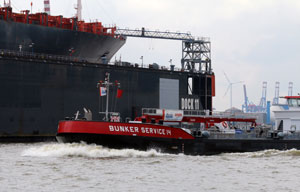While much of the maritime industry is relieved to have an effective date for the 0.5 percent sulfur cap on fuel, the mechanisms for enforcement and ensuring an adequate supply remain to be seen.
Under the latest decision by the International Maritime Organization (IMO), the 0.5 percent sulfur cap for marine fuel (outside of Emission Control Areas) will take effect Jan. 1, 2020. There had been discussion of an implementation date of 2025, but the IMO’s Marine Environment Protection Committee (MEPC) decided on the earlier date.
Shipowners now have a time frame to determine their course of compliance, either using low-sulfur bunker fuel, installing scrubbers to clean exhaust gas or switching to an alternative fuel such as liquefied natural gas (LNG).
Two recent industry studies resulted in varying forecasts for the availability of 0.5 percent sulfur fuel, which is also in demand for landside consumption. A study contracted by the IMO reported that there might be pockets of unavailability for the fuel in the short term, but otherwise it should be widely available.
The shipping group BIMCO, however, said the IMO study was flawed. BIMCO said its own study concluded that it is unlikely there will be sufficient low-sulfur fuel available in 2020 while maintaining an uninterrupted supply to all other sectors of the global economy.
BIMCO raised the concern that fuel of sufficient quality and quantity might not be available, and global demand could drive up prices for all users of low-sulfur fuel.
To meet the increased demand from the maritime industry, refineries may have to invest in additional streams at significant cost. The International Chamber of Shipping (ICS) estimates that compliant fuel will cost 50 percent to 100 percent more than the fuel that ships currently burn.
Kathy Metcalf, president and CEO of the Chamber of Shipping of America, also a member of the ICS delegation, said the industry did not express an opinion on the effective date but rather decided to focus on the transition and implementation — whenever it may be.
“We’re going to get involved during the interim to ensure that the IMO develops a robust enforcement system for the cap,” Metcalf said. “In other words, we don’t want people cheating.”
The U.S. chamber favors an enforcement system similar to the one used in the North American and Caribbean Emission Control Areas. In the event a vessel can’t source 1 percent sulfur fuel, the Environmental Protection Agency allows vessel operators to record the efforts and notify the EPA in advance. If fuel is purchased that is delivered as 1 percent but later is determined to have a higher sulfur content, operators can notify the agency of the discrepancy to avoid penalties.
“We need to have that kind system created internationally so that vessels can be very transparent and notify the authorities they tried to source 0.5 percent fuel and show some justification … and move forward,” Metcalf said.

